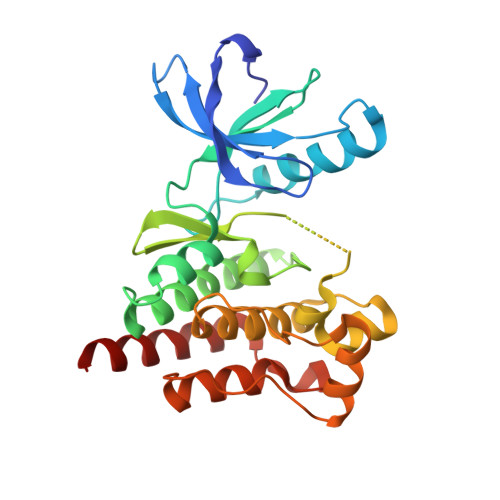Allosteric Regulation of Focal Adhesion Kinase by Pip2 and ATP.
Zhou, J., Bronowska, A., Le Coq, J., Lietha, D., Grater, F.(2015) Biophys J 108: 698
- PubMed: 25650936
- DOI: https://doi.org/10.1016/j.bpj.2014.11.3454
- Primary Citation of Related Structures:
4D4R, 4D4S, 4D4V, 4D4Y, 4D55, 4D58, 4D5H, 4D5K - PubMed Abstract:
Focal adhesion kinase (FAK) is a nonreceptor tyrosine kinase that regulates cell signaling, proliferation, migration, and development. A major mechanism of regulation of FAK activity is an intramolecular autoinhibitory interaction between two of its domains--the catalytic and FERM domains. Upon cell adhesion to the extracellular matrix, FAK is being translocated toward focal adhesion sites and activated. Interactions of FAK with phosphoinositide phosphatidylinsositol-4,5-bis-phosphate (PIP?) are required to activate FAK. However, the molecular mechanism of the activation remains poorly understood. Recent fluorescence resonance energy transfer experiments revealed a closure of the FERM-kinase interface upon ATP binding, which is reversed upon additional binding of PIP?. Here, we addressed the allosteric regulation of FAK by performing all-atom molecular-dynamics simulations of a FAK fragment containing the catalytic and FERM domains, and comparing the dynamics in the absence or presence of ATP and PIP?. As a major conformational change, we observe a closing and opening motion upon ATP and additional PIP? binding, respectively, in good agreement with the fluorescence resonance energy transfer experiments. To reveal how the binding of the regulatory PIP? to the FERM F2 lobe is transduced to the very distant F1/N-lobe interface, we employed force distribution analysis. We identified a network of mainly charged residue-residue interactions spanning from the PIP? binding site to the distant interface between the kinase and FERM domains, comprising candidate residues for mutagenesis to validate the predicted mechanism of FAK activation.
Organizational Affiliation:
Heidelberg Institute for Theoretical Studies, Heidelberg, Germany.
















